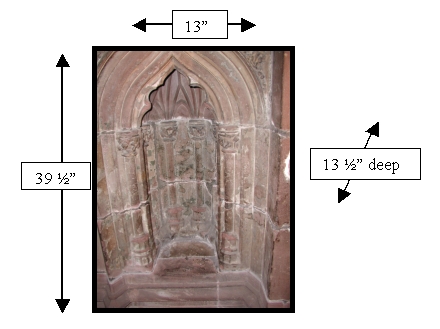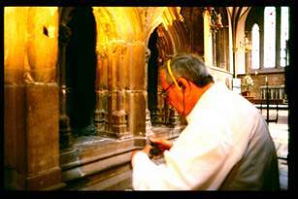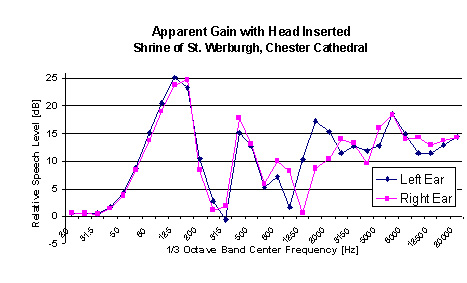David Lubman - dlubman@ix.netcom.com
Acoustical Consultant
14301 Middletown Lane Westminster, CA 92683
Popular version of paper 2aAA3
Presented Tuesday morning, November 16, 2004
148th ASA Meeting, San Diego, CA
England's Chester Cathedral (Anglican) houses a shrine to its patron saint, St. Werburgh, a 7th c. Saxon princess of Mercia who became a nun and abbess.
|
|
|
The original shrine may date from as early as the 9th c. It was a place of pilgrimage and reported miracles. It is believed that pilgrims uttered petitions to the saint at the shrine. The present shrine contains six recesses where kneeling pilgrims inserted their heads while speaking their petitions.

Figure 3: Detail of Recess
The sensory experience of petitioning pilgrims surely comprised emotionally powerful theater. Can the sensory acoustical experiences of medieval pilgrims at this shrine be reproduced for contemporary listeners? To find out, binaural recordings were made of utterances spoken into a recess.

Figure 4: Author wearing binaural microphone, kneeling at
Shrine in preparation for digital recording
The investigator twice reads portions of a prayer to St. Werburgh. In sound file 1 the talker's head is outside of the recess. In sound file 2 the talker's head is fully in the recess. The recording gain is unchanged. The talker has endeavored to use the same voice effort.
Analyses of the full-length binaural recordings show that vocalizations made with the talker's head in a recess are strongly reinforced and distorted by resonances (the strongest is 25.1 dB @ 125 Hz.) This can be seen in Tables I and II and in the graph below.
Table I: Overall enhancement of voice in recess
|
Weighting
|
Speech Level Enhancement
|
|
Speech Level Enhancement
|
15.5 dB
|
|
A-Weighted
|
10.4 dB (doubling of loudness)
|

Table II: Insertion gain in several 1/3 octave bands
|
1/3 Octave Band Frequency [Hz]
|
Max Insertion Gain [dB]
|
|
125
|
25.1
|
|
400
|
17.8
|
|
2000
|
17.2
|
|
6300
|
18.4
|
Assuming that the acoustical features demonstrated here were extant in medieval times, as seems likely, their impact on the petitioner's experience was surely dramatic. Sonic aspects of the drama must have been central, and would seem to have reinforced the purpose of petition and pilgrimage.
This auditory experience for modern listeners can be improved. By capturing the impulse response of a recess with a talker's head in it, an auditory virtual reality can be created.
With an auditory virtual reality experience, persons located anywhere in the world can speak into a microphone and instantly hear their voices amplified and resonated almost exactly as did ancient pilgrims at the shrine.
Students of medieval history, theology, drama, and psychology, and museum goers can thus be drawn closer to the medieval experience.
It seems possible to add olfactory sensation as well. Imagine adding to the auditory experience the mingled odors of incense and candle wax.
This finding is another in a growing list suggesting that ancients in many cultures had more awareness of acoustics and greater acoustical engineering skills than is generally recognized. We are rediscovering lost acoustic technologies.
St. Werburgh: http://www.newadvent.org/cathen/15588b.htm
Medieval pilgrimage: http://www.intst.net/humanities/vs/pilgrims/motive.htm
Dog Rose Trust: http://www.dogrose-trust.org.uk/
It is emphasized that the original design of the shrine is unknown. The present shrine is a 19th c. restoration of a 14th c. enlargement. It is not known if the earlier shrine(s) had recesses. I speculate that the earlier shrine(s) had fewer recesses. Its enlargement would permit simultaneous use by up to six persons
The shrine has undergone at least two physical transformations in its long history. It was enlarged around 1340, apparently because of its popularity as a place of pilgrimage and reported miracles.
The shrine was smashed by 16th c. Henrician reformers and restored in the 19th c. The restoration returned earlier pieces of the shrine which had been used for podium and canopy of the bishop's throne (in the quire) and in the west end of the nave.